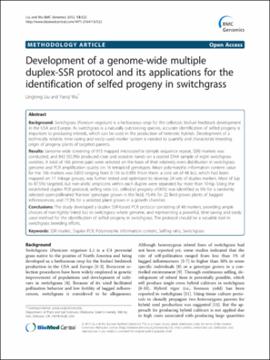| dc.contributor.author | Liu, Linglong | |
| dc.contributor.author | Wu, Yanqi | |
| dc.date.accessioned | 2018-11-09T21:10:48Z | |
| dc.date.available | 2018-11-09T21:10:48Z | |
| dc.date.issued | 2012-10-03 | |
| dc.identifier | oksd_liu_developmentofag_2012 | |
| dc.identifier.citation | Liu, L., & Wu, Y. (2012). Development of a genome-wide multiple duplex-SSR protocol and its applications for the identification of selfed progeny in switchgrass. BMC Genomics, 13, Article 522. https://doi.org/10.1186/1471-2164-13-522 | |
| dc.identifier.uri | https://hdl.handle.net/11244/302057 | |
| dc.description.abstract | Background: Switchgrass (Panicum virgatum) is a herbaceous crop for the cellulosic biofuel feedstock development in the USA and Europe. As switchgrass is a naturally outcrossing species, accurate identification of selfed progeny is important to producing inbreds, which can be used in the production of heterotic hybrids. Development of a technically reliable, time-saving and easily used marker system is needed to quantify and characterize breeding origin of progeny plants of targeted parents. | |
| dc.description.abstract | Results: Genome-wide screening of 915 mapped microsatellite (simple sequence repeat, SSR) markers was conducted, and 842 (92.0%) produced clear and scorable bands on a pooled DNA sample of eight switchgrass varieties. A total of 166 primer pairs were selected on the basis of their relatively even distribution in switchgrass genome and PCR amplification quality on 16 tetraploid genotypes. Mean polymorphic information content value for the 166 markers was 0.810 ranging from 0.116 to 0.959. From them, a core set of 48 loci, which had been mapped on 17 linkage groups, was further tested and optimized to develop 24 sets of duplex markers. Most of (up to 87.5%) targeted, but non-allelic amplicons within each duplex were separated by more than 10-bp. Using the established duplex PCR protocol, selfing ratio (i.e., selfed/all progeny x100%) was identified as 0% for a randomly selected open-pollinated 'Kanlow' genotype grown in the field, 15.4% for 22 field-grown plants of bagged inflorescences, and 77.3% for a selected plant grown in a growth chamber. | |
| dc.description.abstract | Conclusions: The study developed a duplex SSR-based PCR protocol consisting of 48 markers, providing ample choices of non-tightly-linked loci in switchgrass whole genome, and representing a powerful, time-saving and easily used method for the identification of selfed progeny in switchgrass. The protocol should be a valuable tool in switchgrass breeding efforts. | |
| dc.format | application/pdf | |
| dc.language | en_US | |
| dc.publisher | BioMed Central | |
| dc.rights | This material has been previously published. In the Oklahoma State University Library's institutional repository this version is made available through the open access principles and the terms of agreement/consent between the author(s) and the publisher. The permission policy on the use, reproduction or distribution of the material falls under fair use for educational, scholarship, and research purposes. Contact Digital Resources and Discovery Services at lib-dls@okstate.edu or 405-744-9161 for further information. | |
| dc.title | Development of a genome-wide multiple duplex-SSR protocol and its applications for the identification of selfed progeny in switchgrass | |
| osu.filename | oksd_liu_developmentofag_2012.pdf | |
| dc.description.peerreview | Peer reviewed | |
| dc.identifier.doi | 10.1186/1471-2164-13-522 | |
| dc.description.department | Plant and Soil Sciences | |
| dc.type.genre | Article | |
| dc.type.material | Text | |
| dc.subject.keywords | SSR marker | |
| dc.subject.keywords | duplex PCR | |
| dc.subject.keywords | polymorphic information content | |
| dc.subject.keywords | selfing ratio | |
| dc.subject.keywords | switchgrass | |
